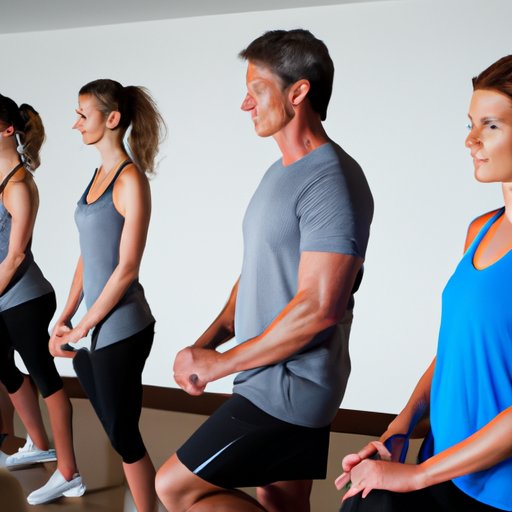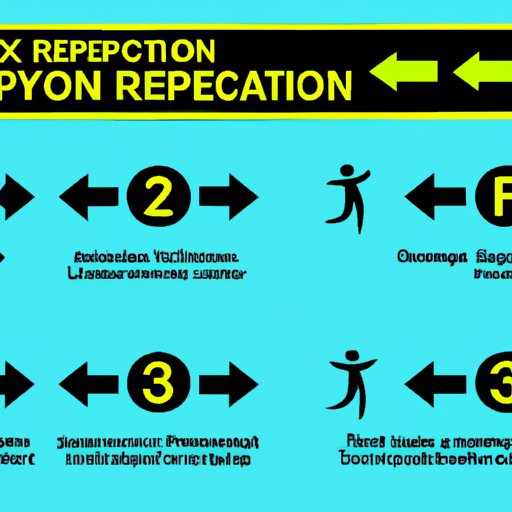Introduction
Repetition in exercise is the practice of repeating movements or exercises multiple times. It is an essential component of any fitness routine and can be used to target specific muscles, improve performance, and increase endurance. Understanding the role of repetition in exercise and how to incorporate it into your workouts can help you reach your fitness goals and maximize the effectiveness of your workouts.
Exploring the Benefits of Repetition in Exercise
Repetition in exercise has several benefits that can help you reach your fitness goals. These benefits include improved performance, increased endurance, and development of muscle memory.
Improved Performance
Regularly performing repetitions of a particular exercise can help you improve your performance in that exercise. By repeating the same movement over and over again, you can become more efficient at that movement and make it easier to do with proper form and technique. This can lead to better results from your workouts and help you reach your fitness goals.
Increased Endurance
Another benefit of repetition in exercise is that it can help you increase your overall endurance. By regularly repeating exercises, you can gradually increase the amount of time you can perform them for without becoming overly fatigued. This can help you maintain your intensity during workouts, which can lead to better results.
Development of Muscle Memory
One of the most important benefits of repetition in exercise is that it can help you develop muscle memory. By regularly repeating the same exercises, your body will become accustomed to them and eventually be able to perform them more efficiently. This can help you get the most out of your workouts and avoid injury.

A Guide to Understanding Repetition in Exercise
In order to get the most out of repetition in exercise, it’s important to understand the different types of repetitions and their benefits. There are two main types of repetitions: high-intensity repetitions and low-intensity repetitions.
Types of Repetitions
High-intensity repetitions involve performing the same exercise at a very high level of intensity for a short period of time. This type of repetition is often used to target specific muscles and can help you develop strength and power. Low-intensity repetitions involve performing the same exercise at a lower intensity for a longer period of time. This type of repetition is often used to build endurance and can help you improve your overall fitness.
Benefits of Different Types of Repetitions
Both high-intensity and low-intensity repetitions have their own benefits. High-intensity repetitions can help you build strength and power, while low-intensity repetitions can help you build endurance and improve your overall fitness. Depending on your goals, you may want to incorporate both types of repetitions into your workout routine.

How Repetition Helps Improve Performance in Exercise
Repetition plays an important role in improving performance in exercise. By regularly performing the same exercises, you can become more efficient at them and become better at performing them with proper form and technique. This can help you get the most out of your workouts and reach your fitness goals.
The Role of Repetition in Improving Performance
Repetition can help you improve your performance by making it easier to perform exercises with proper form and technique. By repeatedly performing the same exercises, your body will become accustomed to them and you will be able to perform them more efficiently. This can help you increase the intensity of your workouts and get better results.
Examples of How Repetition Can Be Used to Improve Performance
There are many ways to use repetition to improve performance in exercise. For example, you could perform high-intensity repetitions of an exercise to target specific muscles and build strength and power. You could also perform low-intensity repetitions of an exercise to increase your endurance and improve your overall fitness. Additionally, you could create an exercise routine based on repetition to ensure that you are consistently challenging yourself and pushing yourself to reach your goals.
The Role of Repetition in Exercise Routines
Creating an exercise routine based on repetition can be beneficial in several ways. It can help you stay motivated, as you will be able to track your progress as you repeat exercises. It can also help you focus on specific areas of your body, as you can tailor your routine to target certain muscles. However, relying too heavily on repetition can lead to overuse and fatigue, so it’s important to mix up your routine and challenge yourself with new exercises.
Advantages of Creating an Exercise Routine Based on Repetition
Creating an exercise routine based on repetition can help you stay motivated and focused on reaching your fitness goals. It can also help you track your progress, as you will be able to see how you have improved over time by repeating the same exercises. Additionally, it can help you focus on specific areas of your body, as you can tailor your routine to target certain muscles.
Disadvantages of Relying Too Heavily on Repetition
Although repetition can be beneficial, relying too heavily on it can lead to overuse and fatigue. Overusing the same muscles can cause them to become overworked and lead to injury. Additionally, if you don’t mix up your routine and challenge yourself with new exercises, you may find that your workouts become monotonous and less effective.

Exercising with Repetition: What You Need to Know
Incorporating repetition into your exercise routine can be beneficial, but it’s important to understand how to do it correctly. Here are some strategies for incorporating repetition into your workout and tips for avoiding overuse and fatigue from repetition.
Strategies for Incorporating Repetition into Your Workout
When incorporating repetition into your workout, it’s important to focus on both high-intensity and low-intensity repetitions. High-intensity repetitions can help you build strength and power, while low-intensity repetitions can help you build endurance and improve your overall fitness. Additionally, it’s important to mix up your routine and challenge yourself with new exercises in order to avoid overuse and fatigue.
Tips for Avoiding Overuse and Fatigue from Repetition
It’s important to take breaks between sets of repetitions in order to allow your muscles to rest and recover. Additionally, it’s important to mix up your routine and challenge yourself with new exercises in order to avoid overuse and fatigue. Finally, it’s important to listen to your body and adjust your routine accordingly.
Conclusion
Repetition in exercise is an essential component of any fitness routine. It can help you improve your performance, increase your endurance, and develop muscle memory. Understanding the role of repetition in exercise and how to incorporate it into your workouts can help you reach your fitness goals and maximize the effectiveness of your workouts. With the right strategies and tips, you can use repetition to your advantage and reach your fitness goals.
(Note: Is this article not meeting your expectations? Do you have knowledge or insights to share? Unlock new opportunities and expand your reach by joining our authors team. Click Registration to join us and share your expertise with our readers.)
